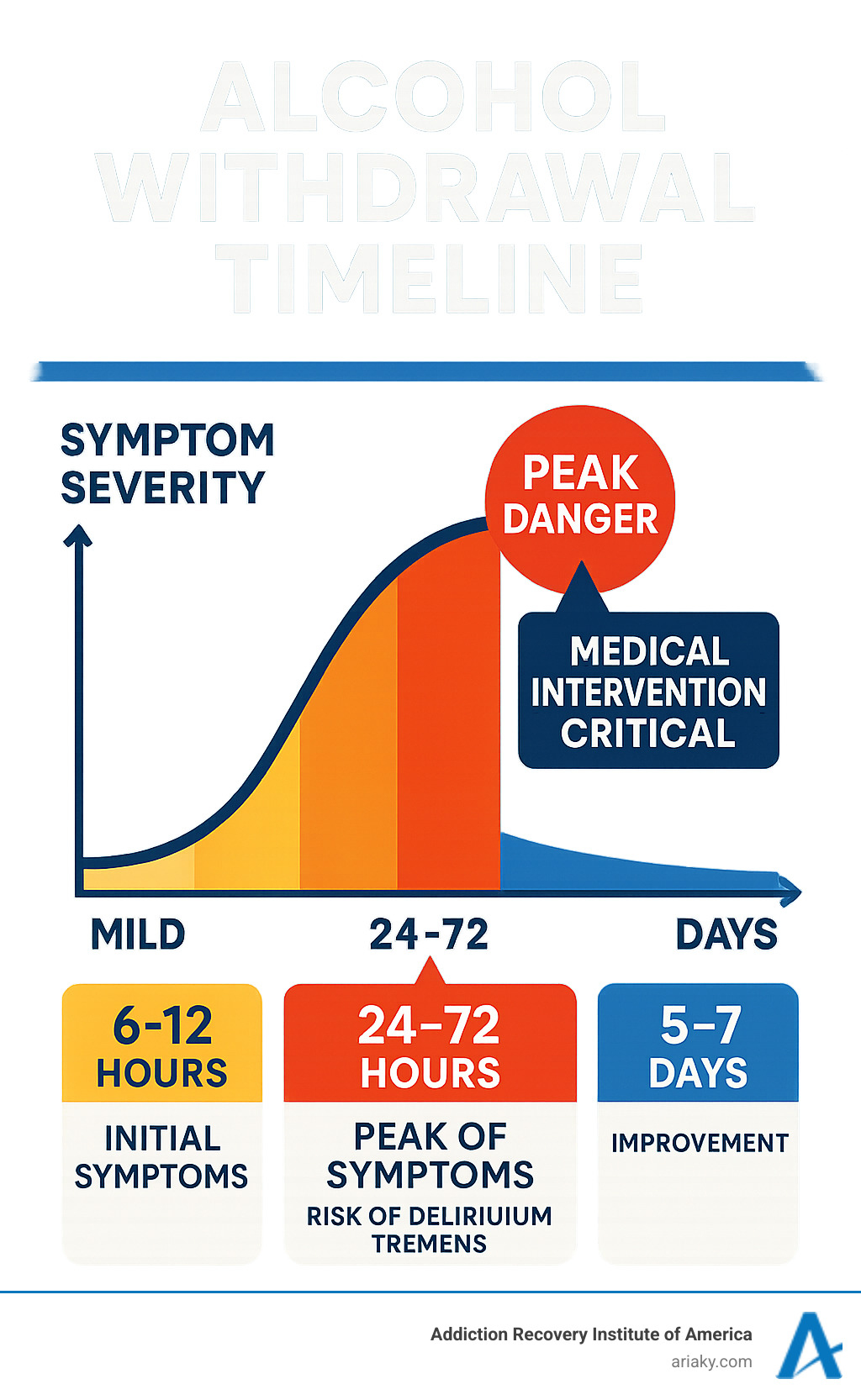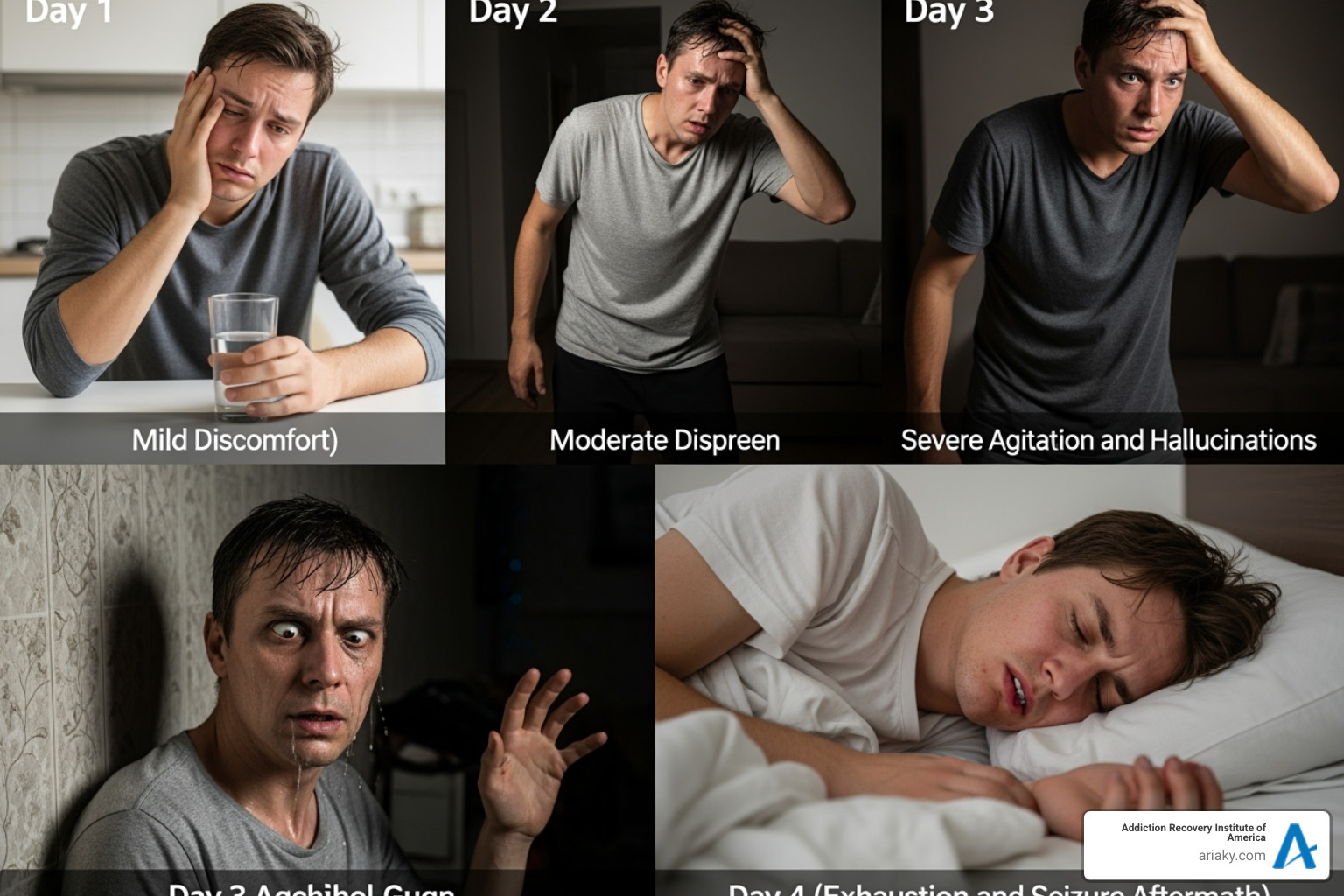Understanding the Alcohol Withdrawal Timeline
The alcohol withdrawal timeline is a predictable pattern of symptoms that occur when someone with alcohol dependence stops or significantly reduces their drinking. Based on research involving thousands of individuals, here’s what you can expect:
Quick Timeline Overview:
- 6-12 hours: Initial symptoms begin (anxiety, nausea, headache)
- 24-72 hours: Peak intensity with severe symptoms (tremors, high blood pressure, seizures)
- 48-72 hours: Risk of delirium tremens (DTs) – a medical emergency
- 7-10 days: Physical symptoms typically resolve
- Weeks to months: Psychological symptoms may persist (PAWS)
About 50% of people with alcohol use disorder experience withdrawal symptoms when they stop drinking. The severity and duration depend on factors like how much you’ve been drinking, for how long, and your overall health.
Why understanding this timeline matters: Alcohol withdrawal isn’t just uncomfortable – it can be life-threatening. Severe complications like seizures and delirium tremens can be fatal without proper medical care. That’s why medical supervision during detox isn’t just recommended, it’s often essential for safety.
The withdrawal process happens because your brain has adapted to alcohol’s presence. When you suddenly remove alcohol, your nervous system becomes overactive, leading to the cascade of symptoms that follow a predictable pattern.

A Detailed Look at the Alcohol Withdrawal Timeline

Understanding the alcohol withdrawal timeline means recognizing how your body responds when it suddenly has to function without alcohol. Think of it like removing training wheels from a bike – your system has to relearn how to balance on its own.
The process unfolds in predictable stages, though everyone’s experience is unique. What starts as mild discomfort can progress to serious medical complications if not properly managed. That’s why knowing what to expect at each stage is so important for your safety and peace of mind.
Most people experience physical symptoms like shaking, sweating, and nausea, while psychological symptoms include anxiety, mood swings, and sleep problems. The good news? Acute symptoms typically last about a week to ten days, though some psychological effects can linger longer.
Stage 1: The First 6-12 Hours
Your body doesn’t waste time letting you know something’s changed. Symptoms can begin within 6 hours of your last drink, sometimes catching people off guard.
During these first crucial hours, you might notice anxiety creeping in – that restless, uneasy feeling that’s hard to shake. Insomnia often follows, making it difficult to fall asleep or stay asleep when you need rest most.
Physical symptoms start showing up too. Nausea and abdominal pain can make eating challenging, while headaches add to the discomfort. Many people experience heart palpitations – that unsettling sensation of your heart racing or pounding harder than usual.
Sweating becomes common, even when you’re not hot, and you might notice the beginning of tremors – those involuntary shakes, especially in your hands. These early signs are your nervous system’s way of saying it’s working overtime to adjust.
While these symptoms might seem manageable at first, they’re important warning signs that your body is going through significant changes. Don’t brush them off – they’re telling you something important.
Stage 2: The Peak at 24-72 Hours
This is when things get serious. Symptoms typically peak at 24-72 hours after your last drink, and this period carries the highest risk for dangerous complications.
Your cardiovascular system feels the strain during this phase. High blood pressure and increased body temperature become common as your body struggles to regulate itself. Those early tremors often intensify into more severe “shakes” that can affect your whole body.
Confusion might cloud your thinking, making it hard to concentrate or remember things clearly. Some people experience alcoholic hallucinosis – seeing, hearing, or feeling things that aren’t there, though they usually remain aware of their surroundings.
The most concerning risk during this peak period is seizures. These medical emergencies require immediate attention and highlight why professional supervision is so crucial during withdrawal.
Your brain is essentially rebalancing its chemistry during this time. Alcohol has been suppressing your nervous system, and now that it’s gone, everything goes into overdrive. It’s intense, but it’s also your brain working hard to heal itself.
Stage 3: Delirium Tremens (DTs)
Delirium tremens represents the most dangerous form of alcohol withdrawal. This condition occurs 48-72 hours after your last drink and demands immediate medical attention.
DTs involves severe confusion that goes beyond the mild disorientation of earlier stages. People experiencing this often don’t know where they are or what’s happening around them. Agitation becomes extreme, sometimes leading to aggressive or unpredictable behavior.
Fever runs high during DTs, accompanied by profuse sweating as your body’s temperature regulation fails. Hallucinations become vivid and terrifying – not the mild distortions of earlier stages, but intense, frightening experiences that feel completely real.
This is a true medical emergency. DTs can be fatal in 5-15% of cases without proper medical treatment. The good news is that with appropriate care, the survival rate is much higher.
If you or someone you know shows signs of severe confusion, high fever, or extreme agitation during withdrawal, call for emergency medical help immediately. This isn’t something to wait out or handle alone.
Stage 4: Post-Acute Withdrawal Syndrome (PAWS)
Just when you think you’re in the clear, your body might have one more challenge in store. While acute symptoms typically last 7-10 days, many people experience lingering effects for weeks or even months.
Post-Acute Withdrawal Syndrome happens because your brain is still healing and rebalancing itself. Think of it as the difference between fixing a broken bone and fully recovering your strength – the major repair is done, but full healing takes time.
Mood swings can feel like riding an emotional roller coaster. One moment you’re fine, the next you might feel irritable, sad, or anxious without clear reason. Low energy and fatigue persist even when you’re getting enough sleep.
Sleep disturbances often continue long after other symptoms fade. You might struggle with insomnia, have vivid dreams, or wake up feeling unrested. Cravings for alcohol can resurface unexpectedly, sometimes triggered by stress, certain places, or social situations.
The psychological symptoms of PAWS – including ongoing anxiety, difficulty concentrating, and memory problems – remind us that recovery involves more than just getting through the first week. Your brain is remarkable at healing, but it needs time and often professional support to fully recover.
Understanding PAWS helps set realistic expectations for recovery. It’s not a sign that something’s wrong – it’s proof that your brain is working hard to return to healthy functioning.
Factors That Influence Withdrawal Severity

Not everyone experiences the alcohol withdrawal timeline in the same way. If you’re wondering why some people seem to have an easier time while others face severe complications, the answer lies in several personal factors that influence how your body responds to stopping alcohol.
Think of withdrawal severity like a recipe – multiple ingredients come together to create your unique experience. The amount of alcohol you’ve been consuming plays a huge role. Someone who drinks a few beers daily will likely have a very different experience than someone consuming a bottle of vodka every day. Your body adapts to whatever level of alcohol it’s used to receiving, and heavier consumption means more dramatic changes when that alcohol disappears.
The duration of your heavy drinking matters just as much. A person who’s been drinking heavily for twenty years has given their body much more time to become dependent compared to someone who’s been drinking heavily for six months. It’s like the difference between a shallow groove and a deep canyon – the longer the pattern continues, the harder it becomes to change course.
Age is another factor that can surprise people. Older adults, particularly those over 65, often experience more intense and longer-lasting withdrawal symptoms. As we age, our bodies process alcohol differently, and we’re more likely to have other health conditions that can complicate the withdrawal process.
Your overall physical health creates the foundation for how well you’ll handle withdrawal. Pre-existing conditions like liver damage, heart problems, or diabetes can make withdrawal more challenging and potentially dangerous. Even things like dehydration or poor nutrition can intensify symptoms and slow recovery.
Mental health conditions like anxiety or depression don’t take a break during withdrawal – in fact, they often get worse. If you’ve been using alcohol to manage these conditions, withdrawal can feel particularly overwhelming as both the physical symptoms and underlying mental health issues demand attention at the same time.
Here’s something many people don’t realize: if you’ve gone through alcohol withdrawal before, especially if you experienced seizures or delirium tremens, your risk of severe symptoms actually increases with each subsequent withdrawal. This phenomenon, called “kindling,” means your brain becomes more sensitive to withdrawal over time.
Genetics also play a role that’s completely out of your control. Some people are simply born with genetic variations that make them more susceptible to severe withdrawal symptoms, while others may have genetic factors that offer some protection.
At ARIA Kentucky, we understand that your withdrawal experience will be as unique as you are. That’s why we believe so strongly in individualized treatment programs that take all these factors into account. We don’t believe in one-size-fits-all approaches because we’ve seen how different each person’s journey can be.
Our team takes time to understand your specific situation, health history, and risk factors before creating your treatment plan. Because when it comes to something as serious as alcohol withdrawal, personalized care isn’t just better – it’s essential for your safety and success.
Why Medical Detox is Crucial for Safe Withdrawal
When you’re ready to stop drinking, the thought of “going it alone” might feel brave or even necessary. But here’s the truth: attempting to detox from alcohol without medical supervision is like walking a tightrope without a safety net. The alcohol withdrawal timeline is unpredictable, and what seems manageable one moment can become life-threatening the next.
The dangers of quitting “cold turkey” at home are very real. Your body has adapted to alcohol’s presence, and when you suddenly remove it, your nervous system can go into overdrive. Unpredictable symptoms are the biggest concern – those mild tremors at hour 12 can escalate to seizures by hour 24. There’s simply no way to know how your body will respond.
Seizures are a serious risk, especially during that critical 24-48 hour window. These aren’t just uncomfortable – they can cause serious injury or even death if you’re alone and can’t get help quickly. Similarly, Delirium Tremens (DTs) can develop seemingly out of nowhere, turning confusion into a full medical emergency with hallucinations, high fever, and severe agitation.
Your body is also fighting other battles during withdrawal. Dehydration from vomiting and sweating, combined with poor appetite, can throw your electrolytes dangerously out of balance. This puts extra strain on your heart, which is already dealing with liftd blood pressure and rapid heart rate. Heart complications like arrhythmias or even heart attacks become real possibilities, especially if you have any underlying health conditions.
The importance of professional supervision becomes clear when you understand these risks. Having trained medical staff monitoring you 24/7 means someone is always watching for warning signs and ready to act immediately if complications arise.
Medical Treatments for the Alcohol Withdrawal Timeline
Managing the alcohol withdrawal timeline safely requires a carefully coordinated approach. Medical professionals use several proven treatments to keep you comfortable and, most importantly, safe during this vulnerable time.
Benzodiazepines are the gold standard for alcohol withdrawal treatment. Medications like Diazepam (Valium) and Lorazepam (Ativan) work by calming your overexcited nervous system, essentially filling in for alcohol’s calming effects while your brain readjusts. These medications are incredibly effective at preventing seizures and reducing the severity of DTs.
Nutritional support, particularly Thiamine (Vitamin B1), is crucial during detox. Heavy drinking often depletes your body’s vitamin stores, and thiamine deficiency can lead to serious neurological problems. Medical teams typically administer this intravenously to ensure your body gets what it needs quickly.
IV fluids for hydration help restore the balance your body desperately needs. After days or weeks of poor nutrition and the dehydration that comes with withdrawal symptoms, these fluids can make you feel remarkably better while supporting your overall recovery.
The 24/7 medical monitoring means trained eyes are always watching your vital signs. Heart rate, blood pressure, temperature – everything is tracked so medical staff can spot problems before they become emergencies.
Many facilities use symptom-triggered therapy based on the CIWA-Ar protocol. This means your medication is adjusted based on how you’re actually feeling, not just a standard schedule. It’s personalized care that ensures you get exactly what you need when you need it.
The Importance of a Supervised Alcohol Withdrawal Timeline
Choosing medical supervision for your alcohol withdrawal timeline isn’t just about safety – though that’s certainly the most important reason. It’s about giving yourself the best possible start to a new life.
A safe environment removes all the triggers and temptations that might derail your progress. You can focus entirely on healing without worrying about access to alcohol or dealing with the stresses of daily life.
Immediate medical intervention means help is always just seconds away. If your heart rate spikes or you start showing signs of seizure activity, medical professionals can respond instantly. This quick response prevents complications that could otherwise become life-threatening.
Beyond safety, medical supervision manages discomfort in ways you simply can’t at home. While withdrawal is never pleasant, the right medications and supportive care can make it much more tolerable. You don’t have to white-knuckle through the worst of it.
Perhaps most importantly, a supervised detox provides a smooth transition to further treatment. Detox is just the beginning of recovery, not the end. When you’re in a professional setting, you can seamlessly move into comprehensive addiction treatment that addresses the underlying reasons you started drinking heavily in the first place.
At ARIA Kentucky, our comprehensive medical detox services are designed with your safety and comfort as our top priorities. Our accredited facility and experienced medical team understand that every person’s withdrawal experience is unique. We’re here to support you through every hour of the alcohol withdrawal timeline, ensuring you have the safest possible foundation for lasting recovery.
The Long-Term Benefits of Quitting Alcohol
While the alcohol withdrawal timeline can feel overwhelming, there’s something beautiful waiting on the other side. The long-term benefits of quitting alcohol reach into every corner of your life, creating positive changes that many people never imagined possible.
Your body is remarkably resilient and begins healing almost immediately after you stop drinking. Improved physical health becomes one of the most noticeable changes. Your liver, which has been working overtime to process alcohol, finally gets a chance to recover. Reduced liver inflammation often happens within weeks, though it’s important to know that severe scarring from cirrhosis is permanent. Your heart benefits too – blood pressure drops, and your cardiovascular system starts functioning more efficiently.
One of the most welcome changes is better sleep quality. If you’ve been struggling with restless nights or waking up tired, you’re not alone. Alcohol disrupts your natural sleep cycles, especially the deep, restorative stages your brain needs. When you quit, your body refinds what restorative sleep stages actually feel like. You’ll start waking up refreshed instead of groggy, with energy that lasts throughout the day.
The mental changes can be just as dramatic. Improved mental clarity replaces the fog that alcohol creates. Your memory sharpens, your focus improves, and decision-making becomes clearer. Research shows significant brain function improvement in people who quit drinking, with some changes visible within just a few weeks.
Perhaps most meaningful are the repaired relationships that sobriety makes possible. Alcohol often creates walls between us and the people we love most. When you quit, you’re showing them – and yourself – that change is possible. Trust starts to rebuild. Conversations become more genuine. Family dinners feel different when everyone’s really present.
Support for families like Al-Anon can help heal the wounds that alcohol use may have created in your relationships. Recovery isn’t just about you – it’s about everyone who cares about you.
There’s also the financial savings to consider. Heavy drinking is expensive, and many people are surprised to find they’re spending hundreds or even thousands of dollars monthly on alcohol. That money can go toward things that actually improve your life – hobbies, travel, savings, or simply the peace of mind that comes with financial stability.
Your appearance changes too. Clearer skin, brighter eyes, and reduced bloating are common. You’ll have more energy for activities you enjoy, whether that’s hiking, playing with your kids, or pursuing interests you’d forgotten about.
These benefits don’t appear overnight, but they’re powerful reminders of why going through the alcohol withdrawal timeline is worth it. Each day of sobriety is an investment in a healthier, happier future – one that’s absolutely within your reach.
Frequently Asked Questions about Alcohol Withdrawal
When you’re facing the decision to quit drinking, it’s natural to have questions about what lies ahead. The alcohol withdrawal timeline can seem daunting, but understanding what to expect helps you prepare for the journey. Here are the most common questions we hear from people considering recovery.
How long does alcohol withdrawal last?
The alcohol withdrawal timeline isn’t the same for everyone, but there’s a predictable pattern most people follow. Your body starts reacting within 6 to 24 hours after your last drink, and things typically get most intense around the 48 to 72-hour mark.
The acute physical symptoms – the tremors, sweating, nausea, and anxiety – usually peak during those first few days and then start to ease up. For most people, these intense physical symptoms resolve within 7 to 10 days. However, some symptoms like mild tremors and sleep problems can hang around for up to two weeks.
But here’s what many people don’t expect: the psychological symptoms can stick around much longer. We call this Post-Acute Withdrawal Syndrome (PAWS), and it can last for several weeks or even months. You might experience mood swings, low energy, sleep disturbances, and cravings during this time.
The good news? Your brain is incredibly resilient. Full recovery and brain re-stabilization can take up to a year, but each day gets a little easier as your body learns to function without alcohol.
Can you die from alcohol withdrawal?
This is probably the most important question we get, and the honest answer is yes – severe alcohol withdrawal can be life-threatening without proper medical care. This isn’t meant to scare you, but rather to emphasize why professional help is so crucial.
The two most dangerous complications are seizures and Delirium Tremens (DTs). Seizures are most likely to happen between 24 and 48 hours after your last drink. These aren’t just uncomfortable – they can cause serious injury or death if you’re alone and unmonitored.
Delirium Tremens is even more serious. It typically shows up 48 to 72 hours after stopping drinking and involves severe confusion, hallucinations, and dangerous changes in heart rate, blood pressure, and body temperature. Even with the best medical treatment, DTs can be fatal in 1% to 4% of cases.
This is exactly why we never recommend trying to detox alone. At ARIA Kentucky, we’ve seen too many people put themselves at unnecessary risk by attempting to “tough it out” at home. Professional medical supervision during detox isn’t just helpful – it can literally save your life.
What helps with alcohol withdrawal symptoms at home?
We need to be completely upfront about this: if you’ve been drinking heavily for an extended period, detoxing at home is not safe. The risks of seizures and DTs are simply too high to manage without medical supervision. Always, always consult with a doctor before attempting to stop drinking on your own.
That said, for people with very mild withdrawal symptoms and only under strict medical guidance, some supportive measures might include staying well-hydrated with water and electrolyte-rich fluids, eating small but regular meals even when your appetite is poor, getting plenty of rest, and having trusted family or friends nearby for emotional support and to watch for worsening symptoms.
But here’s the critical part: any sign of moderate to severe symptoms – severe tremors, persistent vomiting, confusion, hallucinations, or seizures – means you need immediate medical attention. Don’t wait, don’t try to push through it, and don’t let pride put your life at risk.
At ARIA Kentucky, we always recommend professional medical detox because your safety is our top priority. We’ve created a comfortable, supportive environment where you can go through withdrawal safely, with 24/7 medical monitoring and medications to ease your discomfort. Why take unnecessary risks when expert help is available?
Conclusion
The alcohol withdrawal timeline we’ve walked through together tells a clear story: this isn’t a process you want to face alone. From those first unsettling hours when anxiety and tremors begin, through the dangerous peak at 24-72 hours with risks of seizures and Delirium Tremens, to the lingering psychological challenges of PAWS – it’s a complex journey that demands respect and professional care.
What strikes me most about alcohol withdrawal is how unpredictable it can be. One person might experience mild discomfort while another faces life-threatening complications. The process is genuinely complex and potentially dangerous, which is why going it alone simply isn’t worth the risk.
Here’s the encouraging truth: professional medical help is the safest path forward, and it works. Medical detox provides the safety net you need – constant monitoring, appropriate medications, and immediate intervention if things get serious. It transforms what could be a terrifying experience into a manageable first step toward freedom.
Recovery is absolutely achievable and offers a healthier future. The benefits we discussed – better sleep, improved relationships, mental clarity, financial savings – these aren’t just possibilities, they’re realities for thousands of people who’ve walked this path before you.
At Addiction Recovery Institute of America (ARIA Kentucky), we’ve seen this change happen countless times. Our team understands exactly what you’re going through, and we’re here to provide the expert, compassionate care you deserve. With accredited facilities across Kentucky – from Ashland to Louisville, Lexington to Paducah, and everywhere in between – we’re never far from where you need us. We also serve the West Palm Beach area for those seeking treatment there.
The hardest part is often just picking up the phone. But when you’re ready to take the first step toward recovery with our addiction treatment programs, we’ll be here to guide you through every stage of your alcohol withdrawal timeline and beyond. Your journey to a healthier, happier life starts with that first brave decision to reach out.


